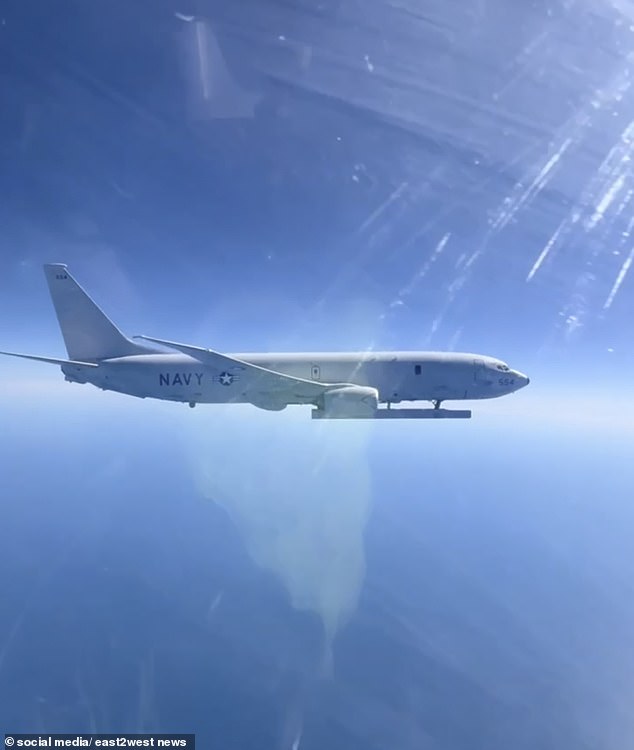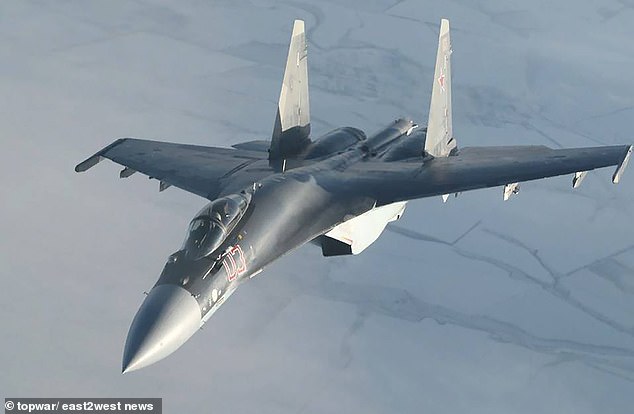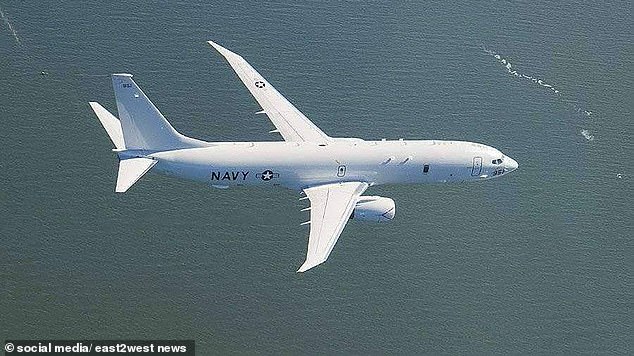A Russian fighter jet was seen intercepting a US anti-submarine spy plane over the Black sea in a tense aerial crash.
Russian sources have said the flight by the Su-35S multirole fighter and P-8A Poseidon aircraft shows the US remains active in intelligence gathering to support Ukraine‘s war effort off the coast of occupied Crimea.
‘The captured payload – traced for the first time – on the American submarine-hunter is of particular interest,’ reported Voyenny Osvedomitel military Telegram channel.
‘The footage shows, beneath the Poseidon’s fuselage, a newly-fitted AN/APS-154 Advanced Airborne Sensor radar.
‘There is not much publicly available information about it, but it is known to be a versatile system designed for detecting submarines, surface vessels, and for coastal reconnaissance.
‘The war in Ukraine has become an excellent testing ground – both for us and for our ‘respected partners’ – to trial the latest types of weaponry under real combat conditions.’
Russia’s escorting £60million Su-35S – the Kremlin’s most advanced 4.5-generation multirole fighter jet, with a NATO reporting name of Flanker-E – evidently did not seek to interfere with the £208million US plane’s flight over international waters in the Black Sea.
It comes just days after Britain’s Royal Air Force scrambled spy planes as it joined NATO in a huge hunt for a Russian submarine suspected of threatening a US aircraft carrier off Norway.

A Russian fighter jet intercepted a US anti-submarine spy plane over the Black sea in a tense aerial crash

Russian sources have said the flight by the Su-35S multirole fighter (pictured) and P-8A Poseidon aircraft shows the US remains active in intelligence gathering to support Ukraine ‘s war effort off the coast of occupied Crimea
In what defence sources called a ‘highly unusual surge’ of activity, NATO allies have deployed at least 27 specialist submarine-hunting sorties since Sunday in an urgent bid to track the vessel.
The Royal Air Force dispatched eight P-8A Poseidon aircraft from RAF Lossiemouth in Scotland, while the Norwegian Air Force launched three more flights from Evenes Air Base near Narvik, deep inside the Arctic Circle.
The US Navy also scrambled patrol planes from a base in Iceland and flown in reinforcements from Sicily to bolster the search effort.
These Poseidon maritime patrol aircraft come with state-of-the-art anti-submarine sensors, torpedoes, missiles and sonar buoys.
They can be deployed to listen for underwater movement, giving NATO forces the ability to detect submarines operating deep below the surface.
Flight tracking websites revealed that one RAF Poseidon spent several hours hovering over the Norwegian Sea, around 60 miles west of the Lofoten Islands.
Many of the aircraft switched off their transponders during the mission to avoid revealing their positions.
The mission is thought to have started at around 7pm on Sunday and ran for nearly 48 hours as aircraft repeatedly scoured the suspected patrol zone.

Russia’s escorting £60million Su-35S – the Kremlin’s most advanced 4.5-generation multirole fighter jet, with a NATO reporting name of Flanker-E – evidently did not seek to interfere with the £208million US plane’s (pictured) flight over international waters in the Black Sea
The Ministry of Defence confirmed the operation was ongoing but refused to disclose any operational details.
A spokesperson said: ‘The UK’s P-8 Poseidon aircraft work continuously on operations, protecting national interests and keeping the UK and our allies safe. For security reasons, we will not comment on operational details.’
However, Ryan Ramsay, a former Royal Navy submarine commander, said the show of force was designed to underline NATO’s dominance in the region.
‘This is NATO showing they are in control,’ he said. ‘Either they have already found the submarine, or submarines, and they are holding it – or they haven’t got it yet and need to get hold of it.’
Similarly, former Navy commander Tom Sharpe added: ‘It looks like they have found a Russian submarine and they are hammering it. It is telling Russia: ‘We see you.’
The incidents come as tensions remain high between NATO and Moscow following Russia’s invasion of Ukraine and increased military activity in the Arctic.
Western officials have repeatedly warned that Russian submarines are capable of disrupting vital undersea infrastructure, including transatlantic data cables and energy pipelines.












